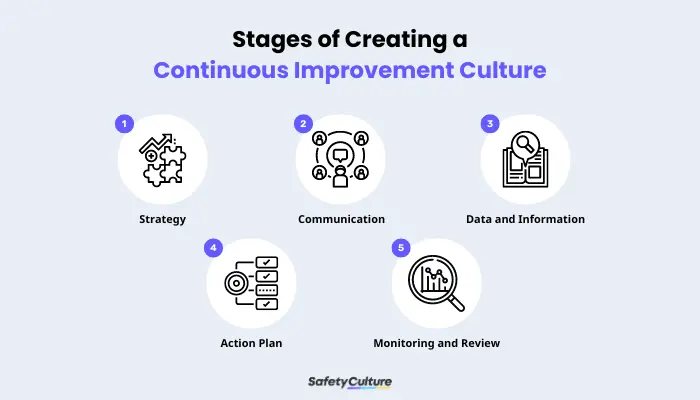What is a Continuous Improvement Culture?
A Continuous Improvement Culture (CIC) is an environment where employees are encouraged to identify areas that require improvement and work collaboratively to develop solutions. It’s considered a system of common mindsets and attitudes that can be detected throughout the people of the organization by putting values and principles into practice.
An organization that has a continuous improvement culture is composed of employees with questioning attitudes and curiosity combined with managers who reward experimentation, see failures as a positive opportunity to learn, and train their team members on how to be professional problem-solvers with the ability to identify and eliminate process waste.
Importance
A continuous improvement culture is of paramount importance for individuals, teams, and organizations striving for long-term success and growth. Here are some key reasons why it holds great significance both in the short- and long-term:
- Boosts Employee Engagement and Retention
- Enhances Customer Satisfaction
- Improves Efficiency and Productivity
- Encourages Innovation
- Promotes Learning and Development
- Fosters a Culture of Transparency and Accountability
- Facilitates Change Management
What Does a Continuous Improvement Culture Look Like?
Building a culture of continuous improvement must be intentional. It has to be grounded in principles, supported by tools and processes, and reinforced with incentives. Since the foundation of a company’s culture is seen in its stated values and guiding principles, these must serve as constant reminders to look towards when making decisions and engaging employees. Principles such as respect for people, an intolerance of waste, providing customers with the most value possible, and a bias towards action, are a good place to start.
Once the guiding principles and values are established they need to be put into action. This is facilitated by the processes and tools that are implemented to manifest culture. Hence, it’s crucial to note that this will require an investment of time and resources to achieve tangible results.
Finally, the information gathered needs to be made visible to everyone and talked about frequently in public and across multiple forums. Incentives should also be given based on the criteria aligned with the company’s goals.
Likewise, employees must be recognized for their efforts and constantly encouraged to find new ways to eliminate waste and improve customer value.
Process

Stages of Creating a Continuous Improvement Culture
Organizations can use this general, step-by-step process of creating a culture of continuous improvement:
1. Strategy
When formulating your strategy to create a culture of continuous improvement, you must make sure certain critical elements are present. First and foremost, continuous improvement needs to be driven by the frontline or your employees in the field. They are the ones who should be identifying the problems, and developing and implementing the improvements. Then, it is the leadership’s responsibility to generate a pervasive message of “Why” around a sense of urgency for the front line to remain engaged and energized to act.
2. Communication
The leadership must have the ability to clearly communicate the values, mission, and goals of the organization with its employees, and that message can be tailored and customized to various audiences up, down, and across the enterprise.
3. Data and Information
The capacity to capture reliable information is the engine of a continuous improvement culture. When workers are well-trained, confident, and capable, they are equipped with the knowledge, experience, and training to recognize opportunities for improvement.
4. Action Plan
When the right things are observed, opportunities for improvement and innovations can be captured and communicated to the leadership. This is where action plans and programs must be concrete and visible to place accountability on the leadership toward the fulfillment of such plans. Hence, this builds trust with the frontline and helps identify and address systemic problems.
5. Monitoring and Review
Operational improvements can also be monitored and correlated with the timing of the actions that have been taken to determine root causes and effective countermeasures. Recognition of the success of these initiatives can then be shared across the organization to further feed the continuous improvement initiative.
Achieve operational excellence
Cultivate a culture of excellence with our digital solutions that enhance efficiency, agility, and continuous improvement across all operations.
Explore nowContinuous Improvement Culture Examples and Best Practices
There are many factors of the equation that need to be in balance in order to maintain the momentum in building and sustaining a continuous improvement culture. Also, investments in time, money, and tools will go a long way toward reassuring employees that the leadership and management are serious about their commitment to the culture they are trying to build.
Apart from those, here are some scenarios of how businesses and companies can implement a culture of continuous improvement and ensure every strategy is aligned with their goals:
- Kaizen Events – Kaizen is a Japanese term that means “change for the better” or “continuous improvement.” It involves conducting focused workshops or events where employees come together to identify and implement improvements in specific processes or areas. These typically follow a structured approach, such as the Plan-Do-Check-Act (PDCA) cycle, and encourage cross-functional collaboration.
- Employee Suggestion Programs – This effort can involve creating an online platform or suggestion surveys where employees can submit their ideas, which are then reviewed, evaluated, and implemented if found viable. Recognizing and rewarding employees whose suggestions are implemented can further motivate others to contribute.
- Agile Methodologies – Agile methodologies, such as Scrum or Kanban, emphasize frequent feedback, collaboration, and adaptability. These allow teams to regularly assess and refine their work processes, leading to continuous improvement.
- Gemba Walks – Gemba is a Japanese term that means “the real place” or “where the work happens.” Gemba walks involve leaders or managers going to the actual workplace to observe and understand the challenges, identify inefficiencies, and gather insights for improvement directly from the frontline workers who are most familiar with the processes.
- Performance Metrics and Data Analysis – By monitoring Key Performance Indicators (KPIs), organizations can identify trends, bottlenecks, or areas of underperformance toward targeted improvements and evidence-based decision-making.
- Quality Circles – These are small groups of employees who meet regularly to identify and solve work-related problems. They focus on quality improvement initiatives and empower employees to take ownership of the continuous improvement process.
- Post-Implementation Reviews – These involve evaluating the results, gathering feedback from stakeholders, and identifying lessons learned to refine processes and ensure continuous learning.
Digitize the way you Work
Empower your team with SafetyCulture to perform checks, train staff, report issues, and automate tasks with our digital platform.
Get Started for FreeFAQs About Continuous Improvement Culture
Continuous improvement culture is closely related to quality management principles, such as Total Quality Management (TQM). It emphasizes the ongoing identification and elimination of waste, defects, and inefficiencies in processes, which ultimately leads to improved quality. Continuous improvement culture also encourages a proactive approach by involving all employees in identifying and addressing issues before they become significant problems.
Involving employees in continuous improvement initiatives lets them feel and know that their inputs and roles are valuable to the success of the organization. Hence, CIC can help lead to organizational benefits, such as the following:
- Empowerment and autonomy
- Recognition and reward
- Collaboration and teamwork
- Personal growth and development
- Sense of purpose
While the specific approaches and methodologies may vary, the fundamental principles of continuous improvement apply universally. As long as the unique requirements and goals of an organization are considered based on the nature of work and industry, embracing a culture of continuous improvement can bring about positive changes, foster innovation, and drive operational excellence to any type of organization.
Technology can play a significant role in supporting this through the following ways:
- Data collection and analysis tools (including analytics software, Internet of Things (IoT) devices, or automated data collection systems)
- Collaboration and communication platforms
- Workflow and process automation
- Knowledge-sharing and learning platforms



